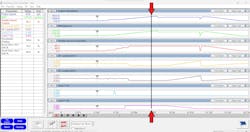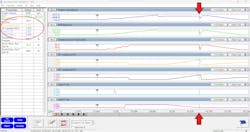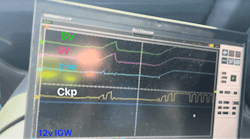Of the 7,139 languages spoken worldwide, it never ceases to amaze me that “drivability” is one language I can speak everywhere I go.
Just recently I had an interesting but difficult conversation with Rayo, a bright young tech from Guadalajara, Mexico. My lack of fluent Spanish and his broken English made conversing a bit of a challenge. Rayo was faced with a strange concern. A 2015 Toyota Land Cruiser, with a 5.7L V8 engine was experiencing what he described as a strange loss of power output. According to Rayo, the engine began to struggle under acceleration between 4,000-5,000 rpm.
The issue seems straight forward but I was faced with educating the young tech on how to obtain the appropriate data (and in the appropriate fashion) to allow for analysis. He was using Toyota’s factory scan tool for this era of vehicle, the Toyota TechStream.
Preliminary Data
After further discussion, he described the loss of power output to be more of an “engine cut-out.” I first viewed the data he sent me to get an idea of what he saw (Figure 1). As you can see, I configured the data PIDs in a customized list from the left of the screen capture in graphical format to see how they correlated with one another. I refer to this as action/reaction comparative measure. I do this to only see the data I need to see. This tells a drivability story. These include:
- MAF
- RPM
- Throttle position
- Lambda 1
- Lambda 2
- Total Trim 1
- Total trim 2
If one multiplies the engine displacement (in liters) by a factor of 37, it will reflect expected grams per second MAF values at 5,000 rpm/full-throttle. According to the data, the engine appears to be breathing correctly under heavy acceleration (219 grams per second). This is good news because from over 2,500 miles away, I can tell for sure that the exhaust isn’t restricted, and the engine has no timing issues.
I can also see that the fuel system is up for the task. The lambda values on both banks indicate the engine is fueled correctly (nearly 20% richer than stoichiometry) and the PCM can carry out that task with no corrective factor (as indicated by nearly zero fuel trim on either bank).
However, something strange occurs about 20 seconds afterward (Figure 2). Although the operating conditions remained unchanged, the data indicates the lambda values (both banks) exceed 1.23 (over 23% lean of stoichiometry). I would’ve expected the fuel trim to attempt compensation but as can be seen, they both remain at zero. Viewing the data from the MAF as well as engine speed shows no variation at all. Any time you see straight lines on graphed data, it typically indicates a state of default, as in, the data isn’t true.
Weighing the Possibilities
Just a moment past the cursor (Red arrows), the vehicle comes back to life and the data begins to update again. This is the symptom Rayo has been experiencing and at this point, I'm growing suspicious of a computer issue. I believe the PCM is resetting for some reason. A few common causes for this scenario are:
- High-energy discharge from an inductive device (like brain damage)
- Loss of PCM voltage, ground or ignition feed
- Loss of 5V reference circuit or (internal PCM fault or external circuit fault)
My advice at this point was to determine which of the three bullet points above was occurring. I advised Rayo to first measure the CKP/CMP signals on a digital storage oscilloscope along with their reference voltage and ground supply circuits. Unfortunately all I can show you is the picture Rayo took with his cell phone (Figure 3).
According to the scope capture, both the CKP and the CMP signals fail at the time the vehicle’s symptom presents. However, the 5V reference voltage that feeds both sensors (allowing them to operate) is dropping out simultaneously.
The Data Doesn’t Lie
With all the information in front of us, and the desired information not yet obtained, we are faced with deciding how to proceed. Here are some bullet points of what we know to be factual, and I will ask all of you, diligent readers, for your input:
- Vehicle loses power under acceleration.
- The engine breathes correctly.
- The engine is properly fueled.
- The PCM appears to be resetting.
Given this information, what would you do next?
- Replace PCM for erratic internally shorted 5V reference.
- Monitor 5V reference circuit at PCM with amp probe.
- Rewire all the 5V reference circuit feeds on the vehicle.
- Replace CKP/CMP sensors for intermittent 5V ref short to ground.
About the Author
Brandon Steckler
Technical Editor | Motor Age
Brandon began his career in Northampton County Community College in Bethlehem, Pennsylvania, where he was a student of GM’s Automotive Service Educational program. In 2001, he graduated top of his class and earned the GM Leadership award for his efforts. He later began working as a technician at a Saturn dealership in Reading, Pennsylvania, where he quickly attained Master Technician status. He later transitioned to working with Hondas, where he aggressively worked to attain another Master Technician status.
Always having a passion for a full understanding of system/component functionality, he rapidly earned a reputation for deciphering strange failures at an efficient pace and became known as an information specialist among the staff and peers at the dealership. In search of new challenges, he transitioned away from the dealership and to the independent world, where he specialized in diagnostics and driveability.
Today, he is an instructor with both Carquest Technical Institute and Worldpac Training Institute. Along with beta testing for Automotive Test Solutions, he develops curriculum/submits case studies for educational purposes. Through Steckler Automotive Technical Services, LLC., Brandon also provides telephone and live technical support, as well as private training, for technicians all across the world.
Brandon holds ASE certifications A1-A9 as well as C1 (Service Consultant). He is certified as an Advanced Level Specialist in L1 (Advanced Engine Performance), L2 (Advanced Diesel Engine Performance), L3 (Hybrid/EV Specialist), L4 (ADAS) and xEV-Level 2 (Technician electrical safety).
He contributes weekly to Facebook automotive chat groups, has authored several books and classes, and truly enjoys traveling across the globe to help other technicians attain a level of understanding that will serve them well throughout their careers.



